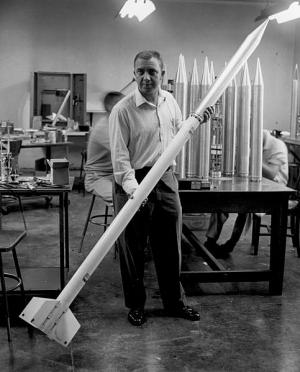Year born: 1914
Research Areas: Earth’s Upper Atmosphere
"I was a kind of a one-man army. I could solder circuits together, I could turn out things on the lathe, I could work with rockets and balloons. I'm a kind of a hybrid between an engineer and a physicist and astronomer."
Source: Wikiquote

Early Life
James grew up in Iowa, USA. He enjoyed anything mechanical or electrical as a child. He constructed a Tesla coil that produced foot-long sparks and caused his hair to stand on end. His mother was not impressed. James studied physics and geophysics at university. At Carnegie Institution he became interested in geomagnetism, cosmic rays, the physics of aurorae, and the Earth’s upper atmosphere.
Career Highlights
Inspired by World War II rocket missiles, James came up with inventive ways to carry scientific instruments high up into the air. He was the first to make a balloon-rocket (or “Rockoon” as they became known) that ascended high above most of Earth’s atmosphere. In 1953, James’s 'Rockoons' were the first instruments to detect bands of radiation around the Earth.
During the ‘Space Race’, James worked on satellite technology. In 1958 Explorer 1 become the second satellite launched into space, after Sputnik in 1957. James managed the design and construction of the scientific equipment onboard the satellites Explorer 1, Explorer 3, and Pioneer 3. Together, these missions discovered doughnut-shaped rings of charged particle radiation trapped by the Earth’s magnetic field. This was the first space-age scientific discovery and the belts became known as the “Van Allen radiation belts”. Over his career, James was the lead scientist on 24 Earth satellite and planetary missions.
Legacy
James received the U.S. National Medal of Science, the country’s highest honour for science. He also received the Crafoord Prize, which is the equivalent of the Nobel prize for space exploration. The Van Allen radiation belts were named for him.
Other Interests
James loved the sea and wanted to join the U.S. Navy. They rejected his application due to his poor eyesight and because he could not swim. James was later able to join the Navy, during World War II. James learned to blow glass and weld while constructing scientific equipment for Antarctic expeditions.
